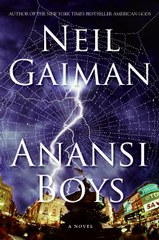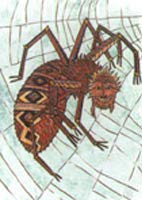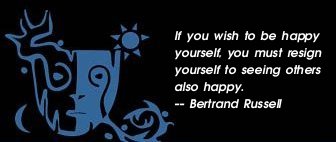|


The Trickster Ananse Redux
by William Doty, Ph. D.,
Professor and Chair Emeritus, College of Arts and Sciences
University of Alabama at Tuscaloosa
When Bill Hynes and I were seeking a publisher for the collection of essays on mythical trickster figures we edited,
we several times had exactly the same responses from evaluators for prospective publishers. The first readers praised the volume to
the skies and said it should have been published yesterday. Then the second readers came along with something like "How could a
respected press like yours even consider publishing such filth?"
As we note (28-31), the West, particularly the Christian West, remains leery of non-puritan humor, is unhappy that "the trickster
is often the official ritual profaner of beliefs" (37), and manages quite well to ignore, for instance, the several female tricksters in the
Israelite tradition (see Exum and Bos, Niditch). As Lewis Hyde titles the seventh chapter of his Trickster Makes the World,
tricksters represent "Speechless Shame and Shameless Speech." He notes that "trickster is amoral, not immoral.
He embodies and enacts that large portion of our experience where good and evil are hopelessly intertwined" (10).
In academia, humor studies are often suspect, tricksters being treated on the margins of literary disciplines — but perhaps
that's all right, since they are by nature represented as boundary breakers, border creatures, and generally anti-establishment miscreants.
Education is by nature conservative, not interested in creative makings of worlds.
African trickster figures have received considerable attention (Pelton); Native American ones have been collected only recently (Erdoes
and Ortiz 1998 and 1984; I treat several in "Native American Tricksters"). General studies include Hyde's great mythological analysis. American
literary figures are treated in Smith and in Reesman's collection of essays. William Bright's delightful A Coyote Reader ranges from Mark
Twain to Gary Snyder and Peter Blue Cloud.

Here I focus upon the West African Ananse (var. Anansi, Annancy, Nanzi, Aunt or Mr. Nancy), as marvelously and hilariously reincarnated
in the novel Anansi Boys
by Neil Gaiman. I've written last month about Gaiman's American Gods, and Anansi appears there as well.
Sten Nadolny's wonderful
twentieth-century reincarnation of Hermes (and other members of the Greek pantheon), in
The God of Impertinence, is a novel of similar quality to Gaiman's, but here I focus only upon the latter.
Both authors have an amazing way of taking traditional mythic figures and bringing them fully into contemporary transformations that
sweat and hiccup and enjoy sex very much. They are fully embodied characters, yet there is a quality of something shimmeringly just off
focus about them. And one mustn't give too many spoilers, so let me just say the endings of both novels are unexpected yet powerful.
The Mr. Nancy of Gaiman's American Gods dies soon into Anansi Boys, and one of his sons, "Fat Charlie" Nancy leaves
his bookkeeping job in London to attend the funeral in Florida. Here he learns that he has a brother, Spider — who realizes much of
the dark side of the Ananse trickster figure (more on that dark aspect in my "Everything You Never Wanted" article), as well as that his
father had been, well, a god.
Replacing Fat Charlie in his own office, Spider gets him fired from his own job and alienated from his fiancée — who initially doesn't
realize her affections have shifted between the two brothers. This is part of what I meant about the out of focus quality: suddenly Fat Charlie
has been out-godded, and hardly realizes that Spider has usurped his London existence — even when Spider comes to live in his mop
closet, and Nancy comes home to find it magically extended out from his house, full of windows and enclosing a jungle of plants and a bubbling
Jacuzzi™.

Now the African Ananse is a pretty powerful god (typically a spider, and Gaiman's own sketch of one is on the cover and last page of the
novel) who "owns all the stories," and clearly his sons can trick one another and rearrange reality at will. Except Fat Charlie is stuck, and finds
his position increasingly untenable, while Spider's star rises and his finances likewise, due to his shenanigans played on Nancy's former boss (who
is a crook).
The fiancée, confronted at mid-novel by both brothers simultaneously can only stumble around in her head: "There were two men
and they looked and sounded completely different, and she still could not work out which one of them was her fiancé.'I'm going mad, aren't I?'
she said, her voice taut. It was easier, now she knew what was wrong" (182-83).
Having once worked on a book on male twin figures, I am struck by how often fictional brothers are contrasts, one thin, the other fat,
one fair, the other swarthy. Here the qualities of the pair are not just matters of appearance, but morally opposed. Suspense builds quickly
as the reader simply has no clue as to the resolution of the interconnections between the two brothers and the two women.
Only another trip to Florida involving a séance that takes Fat Charlie into the spirit world where totemic animal-gods live begins
the sequence of sheer magical resolutions, but I won't betray them here. What I will say is that I don't remember a single page of this novel
that failed to draw peals of laughter: the author's humor is spritely and the idiom exactly on cue. Here's the beginning of the explanation
Fat Charlie receives about how his father died:
He had arrived in the bar early, and had launched the karaoke evening by singing "What's New Pussycat?" which song he had belted out,
according to Mrs. Higgler, who had not been there, in a manner that would have caused Tom Jones to be festooned in flung feminine
undergarments, and which brought Fat Charlie's father a complimentary beer, courtesy of the several blonde tourists from Michigan who
thought he was just about the cutest thing they'd ever seen. (17)
That sort of tight pacing and enfolding narrative is typical, although most of Gaiman's narratives are extremely sparse, the dialogue quick,
and the action also moves along swiftly.
No, I don't think Gaiman "needed" the archetypal trickster figure to structure his novel. Yet it does provide a sort of subtext that lends
an almost mythical quality to this brilliantly secular text.
Works Cited
Bright, William. 1993. A Coyote Reader. Berkeley: U of California P.
Doty, William G. 1995. "Everything You Never Wanted to Know About the Dark, Lunar Side of the Trickster." Spring 57: A Journal of Archetype and Culture 19-38.
- 2001. "Native American Tricksters: Literary Figures of Community Transformers." Reesman 1-15.
Erdoes, Richard, and Alfonso Ortiz, eds. 1998. American Indian Trickster Tales. New York: Viking.
eds. 1984. American Indian Myths and Legends. Part Seven: Coyote Laughs and Cries: Trickster Tales. New York: Pantheon; 333-86.
Exum, J. Cheryl, and Johanna W. H. Bos, eds. 1988. Reasoning with the Foxes: Female Wit in a World of Male Power. Semeia: An Experimental Journal for Biblical Criticism 42.
Gaiman, Neil. 2005. Anansi Boys. New York: Morrow-HarperCollins.
Hyde, Lewis. 1998. Trickster Makes This World: Mischief, Myth, and Art. New York: Farrar, Straus and Giroux.
Nadolny, Sten. 1997. The God of Impertinence. Trans. Breon Mitchell. New York: Viking-Penguin.
Niditch, Susan. 1987. Underdogs and Tricksters: A Prelude to Biblical Folklore. San Francisco: HarperCollins.
Reesman, Jeanne Campbell, ed. 2001. Trickster Lives: Culture and Myth in American Fiction. Athens: U of Georgia P.
Smith, Jeanne Rosier. 1997. Writing Tricksters: Mythic Gambols in American Ethnic Literature. Berkeley: U of California P.
Return to Passages Menu
|

